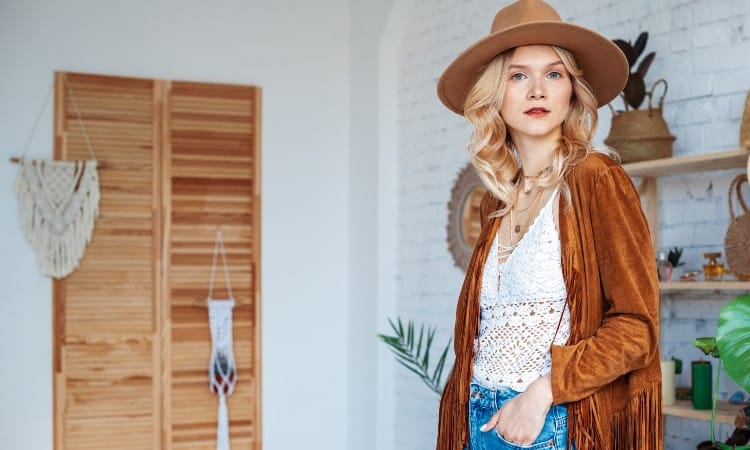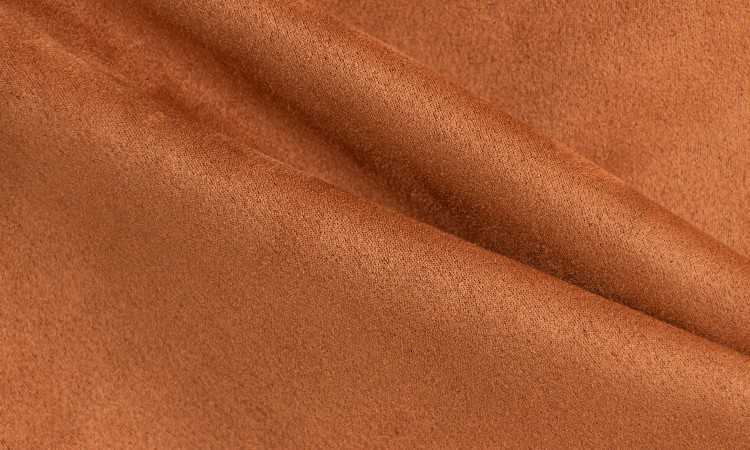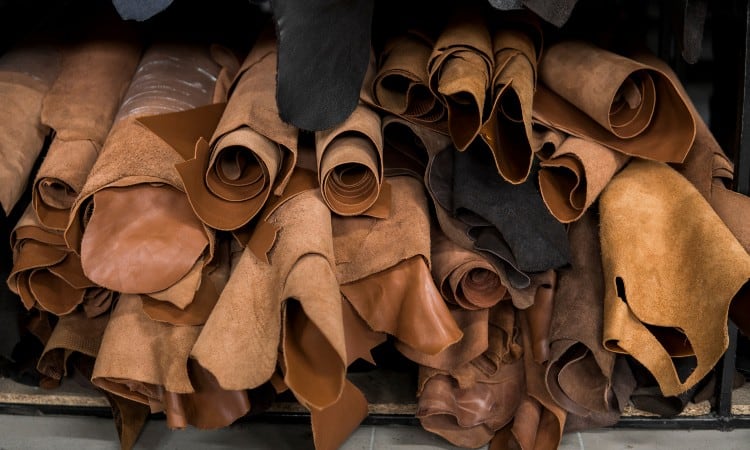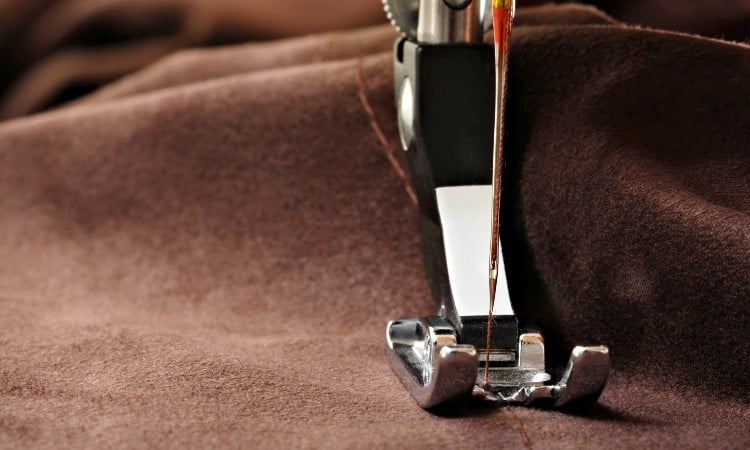One of my favorite materials is suede fabric. It’s so soft and pliable and looks great. I’d love to make my own bag or coat from suede. But, what’s it made from? What is suede fabric?
Suede is a soft, thin luxury leather. While leather is the smooth outer surface of animal skin, suede is the fluffy underside. Made from lamb, deer, pig, and goatskin, suede is easily damaged by water. It needs special care to keep it in good condition. The main uses include coats, bags, and shoes.
In this article, we’ll look at suede in detail, from its history to its many uses. Discover how suede compares to its fabric siblings, leather, and nubuck. With hints and tips on care and working with suede, we’ll tell you all you need to know about the versatile material.

What Is Suede Fabric?
 Suede is a soft fuzzy leather made from the inner surface of animal skin. The name suede originates from the French phrase, “gants de suede”. Its literal translation is “gloves from Sweden”.
Suede is a soft fuzzy leather made from the inner surface of animal skin. The name suede originates from the French phrase, “gants de suede”. Its literal translation is “gloves from Sweden”.
During the French Romantic period of the late 18th Century, Swedish gloves became popular due to the innovative methods used by the Swedish to process leather. Their gloves were the softest available and highly sort after by French noblewomen.
Thinner and not as strong as leather, suede fabric is a luxury material that oozes finery, status, and decadence. With the feel of cotton rather than animal skin, it can be easily mistaken for a plant-based natural fiber.
These days the term suede can refer to any leather with a napped surface. It’s also used for more than gloves. You’ll find suede in jackets, shoes, bags, and even skirts and dresses.
What Is Suede Made Of?
As it’s a type of leather, suede fabric is made from the skin of animals. Usually, suede is made from lambskin, but it can also be made from goats, calves, deer, and pigs. Any animal skin used to produce harder leathers can be turned into suede.
There is one caveat to that, though. Due to suede’s softness, it is normally the skins from younger animals that are used. Older animal skins can be a bit rougher.
Suede can also be made from synthetic fibers like polyester. Artificial suede is known as faux suede, microsuede, or suedette. Designed to mimic the look of suede, synthetic versions tend to feel colder to the touch due to the plastic content.
How Is Suede Made?
The production of suede fabric is similar to the techniques used for all leathers. As it comes from animals, the first stage in the process is the least pleasant.
When animals are slaughtered for the meat industry, they are skinned. These skins are collected and allowed to dry out. At this point, they become known as hides.
Once the hides are dry, lime is added to them. This substance is used to remove any hair follicles from the hide, leaving the surface completely smooth.
Then, to prevent the animal hide from decomposing, enzymes known as tannins are applied. The tannins alter the structure of the hide from living tissue to an immobile, lifeless product. We call this product leather.
Once the leather has been treated with oils and salts, it’s split into different grades or thicknesses. It’s at this stage that some leather is split to show the fuzzy inner surface. This fuzzy section becomes the exterior of the fabric we call suede.
Although it has its nap on full view, the suede will still be a little rough around the edges. It is treated further with a texturing process that smooths out the suede until it is soft and pliable.
Now that the suede fabric has reached this stage, it has the comfortable, luxuriant appearance it’s famous for. Dyes can be added at this point, or the suede can be sold in its natural color. Either by the yard or as ready-to-wear clothing and shoes.
What Are the Advantages of Suede?

As a member of the leather family, suede has a few benefits that make it more appealing than some of its siblings. Let’s take a look at some of the advantages that set it apart from other materials.
Durable and Long Lasting
Being a type of leather but having the soft, flexible feel of cotton, suede has a unique place in the production of garments. Durable and tough, yet delicate and drapable, suede is in a league of its own.
The sheer luxury of suede leather gives an element of soft extravagance to functional items like coats and jackets. Its durability will ensure those items will outlast their cotton counterparts.
Smooth and Soft
When you think of leather, it usually conjures up images of a hard, solid surface, normally cold to the touch. That couldn’t be further from the truth with suede.
Suede is incredibly smooth and soft. So much so it can be difficult remembering that it is, in fact, a type of leather. Having the properties of leather but not the rigidity or harshness is probably its greatest advantage.
Flexible
Talking about rigidity, leather can be inflexible and uncomfortable to wear when it’s new. Buying new leather shoes, in particular, can result in pain. You have to break them in until the leather supples up enough to allow your feet to move freely.
Suede doesn’t have that problem. It’s already soft and supple. A flexible yet hardy fabric, suede will move with your body from the get-go.
What Are the Disadvantages of Suede?
For all its good points, there are some things that make suede an undesirable material. It has to be said; it has its share of disadvantages. Here are just a few of them.
Thin and Easily Damaged
One of the best features of suede is its ability to be flexible and drape well, but it does have an Achilles heel. It can drape because it’s thinner than other leathers. Unfortunately, this is also its biggest weakness.
Being thinner than other leathers means it isn’t as resistant to damage. It will wear out quicker than its thicker leather cousins and start to look worse for wear sooner, especially if it gets wet.
Suede is extremely prone to water damage. As it’s made from the inner surface of animal skin, it isn’t naturally waterproof. Therefore, even the slightest amount of moisture can cause irreparable damage and ruin the garment.
Which can be a bit of a problem when it comes to cleaning. Dirt and dust are attracted to suede fabric like bees to a honey pot. The fuzzy texture can become grimy in a relatively short space of time. Unlike thicker leathers, where the dirt can be wiped off with a damp cloth, suede is less easy to clean.
Can Be Considered Unsustainable
Whether suede is made from leather or synthetic fibers, its sustainability is often in question, albeit for slightly different reasons.
As the natural version is made from animal skin, animals have to be killed to produce it. This can have a negative impact on the environment. Raising livestock can be energy and resource-intensive, especially if you are breeding larger animals like cattle.
Artificial suede is just as troublesome. Made from synthetic fibers, it’s plastic and doesn’t decompose. Being synthetic means its production is dependent on fossil fuels like oil.
Expensive to Purchase and Care For
Suede is a luxury leather and it comes with a price tag to match. Soft, supple, and extremely comfortable, suede has been historically linked to nobility and wealth. Even today, when suede is readily available, the price is high due to its reputation for being a high-end status symbol.
Once you’ve purchased your suede garment, you have to care for it to keep it in tip-top condition. Although you can clean suede at home, you’ll need to have it professionally cleaned regularly for best results.
Types of Suede Fabric

As we’ve seen earlier in this article, the word suede has become the go-to term for any leather with a napped surface. A few other fabrics are also classed as suede due to their similarities to the leather version. Let’s take a look at them.
Genuine Suede Leather
The first fabric on our list is the real deal. Only animal-based leather with a soft, napped finish can be called genuine suede leather. Anything else is imitation suede.
Genuine suede comes in a choice of animal skins. The animal the leather is made from will make a difference to the overall look and feel of the suede.
Sheepskin – also known as lambskin, this one has an almost silk-like feel. Lightweight and thinner than other suede fabric, lambskin has a fine-grain fuzzy texture which is great for clothes.
Pigskin – thick and durable, pigskin makes a heavy suede best suited to work gloves and wallets. It has a short nap making it rougher than suede from sheep.
Cowhide – the roughest of all suede leathers and the most durable. Leather chosen for suede tends to be calfskin simply because it is less rough than full-grown cow skin.
Deerskin – the most expensive option for genuine suede, deer is difficult to process and so not used as often. On a par with lambskin for softness, deerskin has the advantage of keeping the wearer cool in summer and warm in winter.
Synthetic Suede Leather
Synthetic or faux suede has gained in popularity over the years. Cheaper and easier to care for than the real thing, artificial fabrics have become the next best thing in affordable luxury. Here are the most well-known terms for synthetic suede fabrics.
Ultrasuede – Developed by Miyoshi Okamoto in 1970, ultrasuede has become one of the terms for faux suede. Composed of 80% polyester microfiber and 20% polyurethane plastic, this synthetic suede not only looks like the genuine leather version, but it can be machine washed and dried.
Alcantara – is a brand name for ultrasuede. A partnership between Toray Industries and a company called Alcantara, this fabric is used for car interiors and designer handbags.
Microsuede – another term you’ve probably heard of is microsuede. This is actually a faux suede that came into production after the patents expired for ultrasuede. It’s essentially the same design, a polyester microfiber fabric designed to look like the real suede. Not only is it water-resistant and stainproof, but microsuede is also incredibly durable.
Sueded Fabric
A sueded fabric is a non-leather material processed in a way that makes it appear like suede. Unlike faux suede, sueded fabric is usually a natural fiber. Silk, rayon, and cotton can be treated with chemicals to create a suede-like effect. The resulting material is known as suedette and is machine washable.
What’s the Difference Between Suede, Nubuck, and Leather?
Suede, nubuck, and leather are all different forms of the product we know as leather. They are all made from animal skin, but the treatments and production process give each one a unique set of properties.
These properties make suede, nubuck, and leather better suited to some uses. Let’s compare the characteristics in a table so you can see the differences at a glance.
| Property | Suede | Leather | Nubuck |
| Animal | Lamb, Calf, Pig, Deer | Any animal but usually cow, sheep, pig | Usually cowhide |
| Part of animal skin | Inner Layer | Outer Layer | Outer Layer |
| Texture | Fuzzy and pliable | Smooth and stiff | Fuzzy and stiff |
| Durability | Easily damaged by water, dust, and dirt | Very durable | More durable than suede |
Caring for Suede
 Caring for suede can be tricky. It’s notorious for being a high-maintenance material. As it’s made from the inner layer of animal skin, it’s not naturally designed to come into contact with the elements. Or the day-to-day knocks human apparel is subjected to.
Caring for suede can be tricky. It’s notorious for being a high-maintenance material. As it’s made from the inner layer of animal skin, it’s not naturally designed to come into contact with the elements. Or the day-to-day knocks human apparel is subjected to.
Because of this, a genuine suede garment or product will get dirty quickly and is easily ruined by moisture. Which is bad news for us! As it’s also one of the most popular materials for high-end jackets, bags, and coats. So how do you take care of such an easily marked and delicate fabric?
Ideally, you should budget for regular trips to a professional cleaner. That way, you can make sure your suede fabric stays looking good for a long time. There are some things you can do to lessen the risk of damage in between visits, though.
Keep Away From Water
 This one might be easier said than done, but the one thing that is pure kryptonite to your suede jacket or bag is water. Even the lightest rainfall can cause irreparable damage to the delicate suede.
This one might be easier said than done, but the one thing that is pure kryptonite to your suede jacket or bag is water. Even the lightest rainfall can cause irreparable damage to the delicate suede.
The best way to keep it out of the reach of a soggy downpour is to not wear it in the rain. Staying away from rain isn’t always practical, particularly if you live in an area that gets surprise showers.
If you intend to wear your jacket out and about, purchase some suede waterproof solution, like Nikwax Nubuck and Suede Proof, and treat your garment before leaving the house. Follow the directions on the spray can and be aware, you may have to reapply the product. You may also find it doesn’t protect against prolonged exposure to rain, but it should be enough to get you home.
Brush Your Suede
Many daily debris can be removed from your suede by using a specific suede brush or nylon-bristle toothbrush. In the same way, a hairbrush lifts the rigors of the day out of our tresses. Brushing your suede will help dispel the dirt and grime before they can soak into the nap and turn into stains.
Talc and Vinegar
Talc can be used to soak up the moisture from a freshly wet area on your suede fabric. It can’t dry a whole garment, but for a small area, it should help remove the liquid and save the fabric.
Adding a small amount of white vinegar to a dry watermark can help to lift out the stain. However, you do need to exercise extreme caution with this method. Vinegar is a liquid and as well as treating a watermark, it can also cause damage.
If you have a large water-damaged area or are unsure of the safety of using vinegar, always take your garment to a professional cleaner. They will have the products and facilities to care for your suede fabric without causing any further potential damage.
What Is Faux Suede?
 Faux suede is an imitation suede made from either synthetic or natural fibers. Synthetic faux suede is usually made from polyester or a polyester blend. While natural imitations can be cotton or silk. You can also find faux suede made from semi-synthetic rayon.
Faux suede is an imitation suede made from either synthetic or natural fibers. Synthetic faux suede is usually made from polyester or a polyester blend. While natural imitations can be cotton or silk. You can also find faux suede made from semi-synthetic rayon.
Other terms you’ll see when looking for faux leather include microsuede, ultrasuede, or suedette. Regardless of the name, all faux suedes look and feel like genuine suede but are easier to care for and a lot cheaper to buy.
One of the main advantages of a faux suede is its ability to repel water and stains. Moisture doesn’t ruin suede imitation fabrics, which means you can go out in the rain and not worry about the material. Better still, all faux suedes are machine washable. Making them cheaper to care for too!
Is Suede Difficult to Work With?

Suede fabric isn’t difficult to work with as long as you use the right tools. Depending on the thickness of your material, you may find the seams become bulky. Most domestic sewing machines can cope with bulk. You just have to remember to sew on a slow-speed setting and use a longer than normal stitch length.
Whether you are working with genuine suede leather or a faux alternative, you need to use the right needle. The thickness of your suede will determine the size you go for. A leather needle or a jeans needle works well with real suede. Both of those are large needles.
You may have better results on imitation suede if you use smaller needles like a universal needle or a stretch needle. Experiment with a spare piece of suede to see which size will work best on your fabric.
Using a Teflon or a walking foot will help control the suede while you sew. Teflon stops the fabric from sliding as it goes under the sewing machine foot. This is particularly useful if you are working with a polyester-based suede. A walking foot will help the top layer go under the foot at the same speed as the underneath, keeping your seams level. This is great for natural suede fabrics.
As suede is easily damaged, you want to keep the number of holes you put in it to a minimum. Holes from the sewing needle are unavoidable but will be hidden in the seams to a certain extent. Pinholes, on the other hand, will be painfully visible. Always avoid pins when working with suede.
Using a polyester thread will allow movement in the fabric. As polyester is more flexible than a cotton-based thread, there is less chance of your threads breaking when your seams are put under pressure.
Suede Fabric by the Yard
The cost of suede varies depending on the type of fabric and the fiber content it contains. A polyester-based or faux suede is going to be a lot cheaper than a leather suede.
Another factor to consider is the quality of the suede. Regardless of whether it’s genuine or faux, better-made materials will cost more.
As a general rule, genuine suede can be anywhere between $25-$45 per yard. Faux suede can be as cheap as $8 per yard or as much as $13. Where you buy it from also makes a difference to the price.
Conclusion
Suede fabric can be genuine leather or an imitation material made to look like suede. Whether you choose real or faux is up to you and the look you want for your project. Either way, you’ll get a fabric that oozes style and sophistication.
Let me know in the comments if you liked the article. Has this article encouraged you to take another look at suede for your wardrobe? How about trying faux suede? Let me know how you get on.